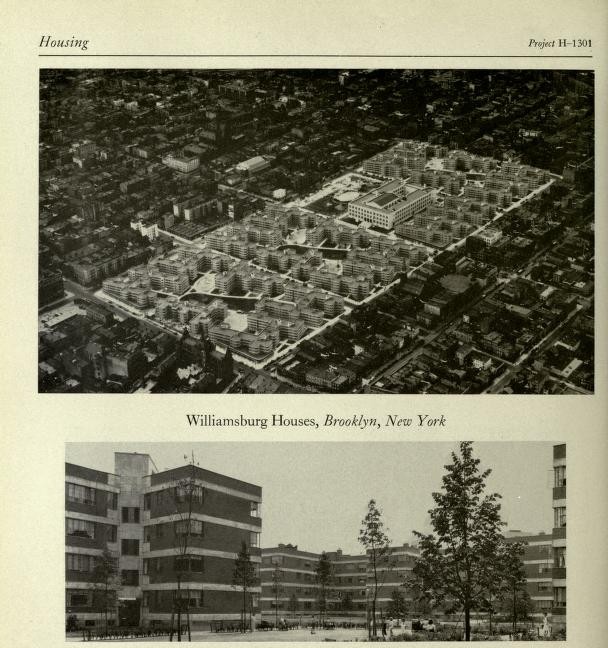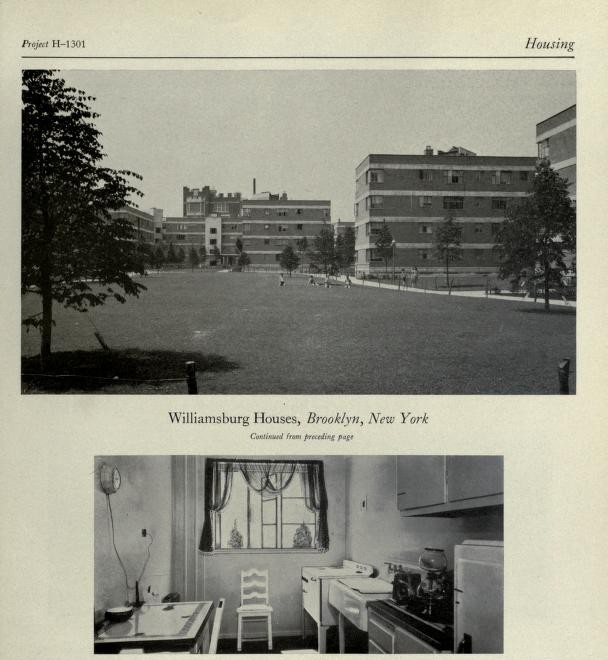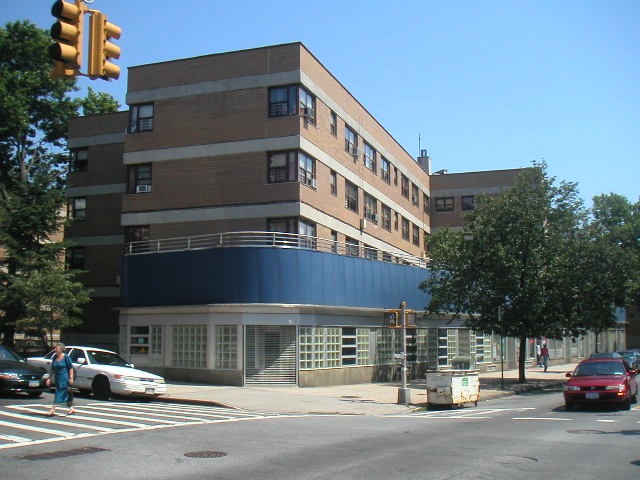- City:
- Brooklyn, New York City, NY
- Site Type:
- Civic Facilities, Public Housing
- New Deal Agencies:
- Public Works Funding, Public Works Administration (PWA)
- Completed:
- 1937
- Designers:
- Richmond Shreve, William Lescaze
- Quality of Information:
- Very Good
- Site Survival:
- Extant
Description
The Williamsburg Houses were opened in 1937, one of three huge public housing projects in New York City funded by the Public Works Administration (PWA), along with First Houses and Harlem River Houses in Manhattan. New York City was the unchallenged leader in the creation of public housing in the United States, beginning in the 1920s, and the New Deal allowed the city to continue to built high-quality public housing that has stood the test of time.
The official PWA history, published in 1939, described the project in detail:
“Williamsburg Houses, the ‘city-within-a-city’ slum-clearance project, erected in the heart of the historic Williamsburg section of the borough of Brooklyn, city of New York, is one of the largest low-rent housing projects undertaken in the United States. It provides homes for 1,622 families in the low-wage brackets. This project occupies 20.2 acres and supplants twelve of the most blighted and congested slum blocks in Greater New York City.
The 5,719 rooms which make up the Williamsburg project are located in 20 fireproof, 4-story walk-up apartment buildings. These structures, covering about 32 percent of the 20.2 acre site, are set at a slight angle from true north and south giving each building a maximum of recreation space, ventilation, sunlights, and the benefit of prevailing summer breezes.
Each building has a full basement providing space for individual laundries and drying rooms, nurseries, social units, and craft rooms. There are, in all, seven craft rooms. There are, in all, seven social units. seven craft rooms, and a nursery school occupying 5,700 square feet. Approximately 3 percent of the 1,622 apartment units are 2-room, 47 percent 3-room, 46 percent 4-room, and 4 percent 5-room units. All rooms open on landscaped courts and park areas. Within the project 49 stores and shops have been leased on private individuals.
The development was first tenanted on September 30, 1937. The average shelter rent, which includes cold water only, is computed on the basis of $6.52 a room per month. The total actual rent averages $8.47 a room per month, which includes all charges for heat, hot and cold water, and electricity for light, cooking, and refrigeration.
The 20.2-acre site, including a half-acre donation by the city, cost $3,745,722. It accommodates 226 rooms to the acre. The structures were completed at a construction cost of approximately $8,708,228, or 57 cents a cubic foot, for a total of 15,230,100 cubic feet. This construction cost is equal to $1,523 a room and $5,363 an apartment unit. The entire development, including land and miscellaneous costs, was fully financed with P.W.A. funds. The total project cost was $12,912,600, which approximates a total cost of $2,258 a room and $7,961 a family-dwelling unit.”
(Short and Brown)
The 1939 WPA Guide to New York City had this to say:
Williamsburg Houses, Scholes Street to Maujer Street, Leonard Street to Bushwick Avenue, is the largest slum-clearance and low-rent housing project completed under the Federal Housing program (1939). Built at a cost of about $12,800,000, the development includes twenty apartment houses, four stories high, accommodating 1,622 low-income families (about six thousand persons).
Together with a landscaped park and numerous playgrounds, the project covers twenty five gross acres, formerly twelve slum blocks. The buildings, occupying only about 30 per cent of the gross area, are grouped into four super-blocks, formed by closing two through streets to traffic. Three blocks have six apartment houses each, the other has two houses the new William J. Gaynor Junior High School, a park, and a playground. Unfortunately, the school is in a rather dull neoclassic style which adds little to the architectural interest of the group.
The houses are placed at a fifteen-degree angle to the streets to orient the buildings toward the sun. The buildings, individually pleasing in design, are of fireproof construction with reinforced concrete floors. Color provides much of their charm–yellow ochre brick, gray cement, blue-gray terra cotta between windows, bright blue doors, and dark blue store front parapets. The floor lines are marked by horizontal bands of concrete, which create an unusual striped effect. Most of the details–entrances, store fronts, etc.–are imaginative and highly successful. The entire group was planned by a committee of architects selected by the New York City Housing Authority, with R. H. Shreve as chairman.
All apartments–two to five rooms–are equipped with electric stoves, refrigerators, and modern plumbing, and supplied with steam heat, hot and cold water. The living room of a typical apartment has a floor area of 150 square feet; the kitchen, 75; and the bedroom, 120.
Williamsburg Houses are under the management of the New York City Housing Authority. Tenants are selected on the basis of income and the need for better housing. No family is eligible whose total income is more than five times the amount of rent plus the cost of utility service. Preference was given to families that had lived on the site of the development, provided they were otherwise eligible as required by law. The first tenants, chosen from a list of more than nineteen thousand applicants, moved into the project in September, 1937, and since then only a few have moved.
Rents, paid weekly in advance, range from $4.45 a week for a two-room apartment to $7.20 for five rooms; electricity for an apartment costs 90 cents to $1.20 a week. Three hundred and ninety-eight residents are employed as clerical workers, 49 as professionals, managers, and officials, 353 as skilled workers, 468 as semiskilled, and 283 as unskilled.
The cultural activities are held in the social and craft rooms of the project and the community center of the high school. The Authority provides space for classes for mothers in child care and psychology, men’s and women’s clubs, a glee club, a tenants’ council, and youth groups, but these activities are initiated and conducted by the tenants themselves. The tenants also publish a semimonthly paper, the Projector.
T. F. Hamlin, in an article in Pencil Points, declared that the Williamsburg development offers more of the amenities of good housing than many expensive Park Avenue apartment houses. “In every really important general matter of land usage–in air, in light, in a sense of green and growing things as a concomitant of living; in the creation of an atmosphere of humanity and decency, a place where children would be glad to grow up; in the development of a community that brings with it a new vision of democracy and of progress,” he said, “[this development has] qualities that no money can buy.”
As for the architecture, it was bold Modernism in its time, designed by some of the city’s finest architects. Professor Andrew Dolkart of Columbia University School of Architecture, Planning and Preservation points out that the Williamsburg Houses project “…is an early example of European modernist planning and design.”
The New York Architecture website (nyc-architecture.com) adds:
“The best public housing project ever built in New York but also the first and most expensive (in adjusted dollars). Its 4-story buildings embrace semiprivate spaces for both passive and active recreation. Reinforced concrete and brick infill is punctuated by pedestrian ways that connect sequential courtyards through stepped and columned portals. The apartments themselves are reached without benefit of corridors by an entry system that opens directly off the stair landings (as in Princeton Collegiate Gothic, here in serene modern dress). The new aluminum doublehung windows are a clunky alteration, replacing elegant slender-mullioned, but unhappily deteriorated, steel casements. Stripped of its original brick, and articulated with blue tiles, the revivified Williamsburg Housing seems a fresh breath of architecture once again.”
(https://nyc-architecture.com)
(It seems, however, that First Houses in Manhattan were built ahead of Williamsburg Houses.)
The Brooklyn-based “Brownstoner” website identifies the architects of the project:
“Working for the New York City Housing Authority (NYCHA), founded in 1934, a team of ten architects, led by Richmond H. Shreve and his head designer, William Lescaze led the project. Shreve was a partner in Shreve, Lamb & Harmon, forever known for their design of the Empire State Building. William Lescaze was a pioneer of the new International Style, a clean, minimalist style of architecture…”
Chief designer William Lescaze wanted to design something different. One of the ideals left over from the City Beautiful Movement, as well as European models of apartment design, was the concept of open spaces and parkland. People need open space to escape from crowded tenements and people living on top of each other. Reformers in the late 19th and early 20th century had pushed for small and large parks in the city for this reason. This part of Williamsburg had no parks, another reason for the choice of this location.”
https://www.brownstoner.com/history/walkabout-the-williamsburg-houses-part-2/
(Unfortunately, the Brownstoner makes the common mistake of confounding the PWA and WPA, wrongly attributing the Williamsburg Houses to the latter).
.
Source notes
C.W. Short and R. Stanley-Brown. "Public Buildings: A Survey of Architecture of Projects Constructed by Federal and Other Governmental Bodies Between the Years 1933 and 1939 with the Assistance of the Public Works Administration." (1939). Brownstoner: "Walkabout: The Williamsburg Houses, Part 2", last accessed March 2016 "GSAPP: Andrew S. Dolkart", last accessed March 2016 New York Architecture: "Williamsburg Houses", last accessed October 2016At this Location:
Site Details
| Total Cost |
|---|
| $12,912,600.00 |
Contribute to this Site
We welcome contributions of additional information on any New Deal site.
Submit More Information or Photographs for this New Deal Site





I lived there in the 1940s and 50s. My family has good stories to tell. We had good friends, and some still live there. I filled out an application to move to a low income housing and hope I can move back into the Williamsburg project.
I lived there having moved in with my parents in 1940 or so. i was two years old, born in 1938.
we moved from a burnt out basement apt in brooklyn slum of east new york.
my father considered a move into heaven and no matter what i did i was constantly reminded to obey housing rules or else we’d be thrown out. a fate worse than prison and execution. and indeed it would have been.
i had so many little buddies that i never thought of myself as an only child.
we kids ruled the roost. just don’t dare drag a stray cat or dog past outside building entrance.
a painted turtle managed to slip thru the rules!!!!!
Left in my wedding gown age 20. too young.
but life on the third floor in the smaller of the buildings.,two apts to a floor was safe, clean and peaceful.
and for my father, working for 38 years at the AUTOMAT in manhattan, security…
so much to tell but i’ll leave it at that.
the williamsburg houses are alive and well in my past and my dreams.
beatrice mendetz
age 79
philadelphia, pa
I lived in the Williamsburg houses for about 16 years. In fact, I was born there. I lived at 164 Ten Eyck Walk. Anyone else live there in the 50s and 60s?
Rosemarie
I will like to go back if it’s possible I still got family live in there I miss my projects
I don’t know why they did not include a dining room in each apartment. The kitchen is so small and the living rooms are small as well and has to be divided into a dining/living room. I’ve lived here for twenty-four years and I have had to make due without a dining room area. The kitchen is too small for even a dinette set. I wish they would break down the wall to make room for at least a small dinning room area. I don’t know what the designers were thinking. Perhaps they felt that poor people didn’t deserve to eat a meal in a decent room and so we are forced to sit on our sofas with our dinner plates on our laps. The stairwells looks like a factory or prison stairwell and there are windows on each floor landing but no heating system to keep us warm. They use to have radiators but for some reason, they took them out. I can go on about no heat in the apartments, mole and walls bubbling up and many other issues but at this point, I’ll just leave it alone and say, thank God I have a place to live and hopefully with the renovations it will be worthwhile. Otherwise, it’s better than being homeless. I am grateful to have a roof over my head and I have managed to make this apt a home and a safe haven for me and my husband.
I lived in the Williamsburg Projects from the time of my birth in 1953 until I was 15. After that, when my mother passed away, I lived in East New York with my aunt but went home to the Projects to stay with my father on weekends. He lived there until he passed away in 1982. It was wonderful growing up there as I had friends all over, not only on my block but also on other blocks. There was a lot of ground to run around in and play with my friends. There were the arches and sculptures (like the monkey bars” to play on. As I look back now and read some of the comments, I realize that indeed, we had no dining room and a small kitchen. However, we made do. It was a great place to be a child with many friends to play with.
I lived at 224 Ten Eyck Walk, in 3 rooms from 1937 to 1950. We were in the middle building between, 222 and 226. Since we were 3 people, Elaine (me) a 5 year old, my mother Dorothy 23 and her mother Nannie Fay 41, with no male presence, we were the talk of the town. There were 3 apartments on our floor, ours, Mr and Mrs Beane and their daughter Jean (a teenager who never smiled (maybe because she was teased Jean Beane, Jean Beane) and Mr. and Mrs Jordan with a lovely friendly daughter. Other neighbors in our building were the Englanders and the Doctors, In 222 on the 4th floor lived the Meltzers, friends to this day and 226 had the Schwartz’s were my dear friend Roz and her brother William and sister Beatie lived with just a mother and an occasional visiting father Sol. The ethnic mix were Jews, Italians, some Polish, but no people of color that I remember. Our grade school was PS 149 called William J Gaynor although we never knew who he was. The school ranged from kindergarten to 6th grade and my favorite teacher was Miss Fagan. After 6th grade the girls were sent to PS 196 on Bushwick Avenue. My memories are long and clear and vivid. We were introduced to left wing thinking and an appreciation of music and art. The mix was healthy and cooperative and long lasting. The war led my Nannie to the War effort and she became an Air Raid Warden and very very close friend of Sgt Keenan from the Police Station a block away. My mother joined a group working for the Russian War Relief and I became a Brownie and Girl Scout. I could go on and on and on……
I lived at 91 Scholes street since birth until we moved when I was 19 years old in 1962.So my growing up years were the 40’s and 50’s
We had a 3 bedroom apartment which seemed very spacious.On the first floor. Lived there with besides parents, my older sister and younger brother as well as my grandma(she died when I was 8). Our court was loaded with kids and no matter the age we all played together.One of my closest friends lived above us and we could open the cover of the heat pipes and talk to each other.Went to PS 149 through 6th grade, then JHS 196, then Eastern District and graduated there in 1960. Still in touch with friends that I grew up with and had happy memories. When I was 19, parents moved to Nostrand Houses in Sheepshead Bay.